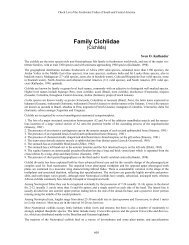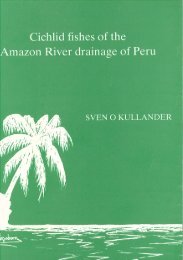Open Access PDF - Sven Kullander
Open Access PDF - Sven Kullander
Open Access PDF - Sven Kullander
You also want an ePaper? Increase the reach of your titles
YUMPU automatically turns print PDFs into web optimized ePapers that Google loves.
uito, Rio Aguaro on the way towards Hato Aguaro,<br />
west of Santa Rita (Garcerito); 10 Jan 1995, D. C. Taphorn<br />
et al. – MCNG 33198, 2, 181-190 mm SL; Bolívar: Laguna<br />
El Potrero; 23 Apr 1988, M. Rodriguez. – ZSM<br />
25020, 2;Bolívar: Laguna de Palma at San Felix; 29 Mar<br />
1974, H. J. Köpke. – ZSM 25269, 2; Amazonas: Rio<br />
Atabapo at San Fernando; 5 Feb 1973, H. J. Köpke & M.<br />
Jeschke. – ZSM 23838, 2, 136.2-136.4 mm SL; Monagas:<br />
Barrancas, Laguna Los Guateguas; 11 Nov 1963, F.<br />
Mago L. Rio Caroni drainage: Bolívar: NRM 12038,<br />
1, 57.6 mm SL; Embalse de Guri, 7 km W of El Manteco;<br />
6 Apr 1990, U. Werner et al. – NRM 22918, 2, 79.0-<br />
99.6 mm SL; Guri Reservoir-Rio Caroni Los Arrendajos;<br />
4 Dec 1993, J. D. Williams et al. – NRM 21547, 1, 233 mm<br />
SL, NRM 21549, 1, 246 mm SL, NRM 21550, 1, 291 mm<br />
SL; NE part of Embalse del Guri, Los Arrendajos; 16<br />
Jan 1994, J. D. Williams. – NRM 21548, 1, 267 mm SL;<br />
NE part of Embalse del Guri, Zona F, near Dique F; 16<br />
Feb 1994, J. D. Williams. – NRM 22920, 6, 55.6-60.2 mm<br />
SL; NE Guri Reservoir, near dique F; 6 Jun 1994. J. D.<br />
Williams et al. Brazil: Rio Negro drainage: Amazonas:<br />
BMNH 1915.11.1:12, 1, 290 mm SL; Manaus; Clark. –<br />
MZUSP 92402, 2, 146.2-200 mm SL; vicinity of Manaus;<br />
15-23 Nov 1967, EPA. – MZUSP 6793, 7, 90.4-232 mm<br />
SL; Igarapé Tarumãzinho, affluent no. 1; 17-18 Nov<br />
1967, EPA. – MZUSP 6839, 12; Igarapé no 2 tributary to<br />
Igarapé Tarumãzinho, N of Manaus; 18 Nov 1967, EPA.<br />
– MZUSP 27214, 2; mun. Moura, Pedra do Gavião; 13<br />
Nov 1982, L. Portugal. – MZUSP 92407, 6 juvs.; mun.<br />
Novo Ayrão, extreme north of Reserva Ecologica<br />
Anavilhanas; 6 Nov 1982, L. Portugal. – MZUSP 32758,<br />
4, 261-278 mm SL; Rio Arirará near mouth; 8 Oct 1979,<br />
M. Goulding. – MZUSP 33121, 2 (1 measured, 99.0 mm<br />
SL); Ilha de Tamaquaré, central lake; 11 Oct 1979, M.<br />
Goulding. – MZUSP 33124, 4; Barcelos; 29 Feb 1980, M.<br />
Goulding. – MZUSP 33125, 1; Barcelos; 29 Jan 1980, M.<br />
Goulding. – NRM 18347, 1, 65.2 mm SL; Paraná do<br />
Marauiá; Jan 1987, M. Goulding – ZSM 23837, 4; Igarapé<br />
Castanha at Manaus; 23 Oct 1965; J. Géry & E. J.<br />
Fittkau. Rio Branco drainage: MZUSP 33122, 1; Roraima:<br />
Marará, praia; 26 Oct 1979, M. Goulding. Rio<br />
Amazonas drainage: MZUSP 6113, 1, 189 mm SL;<br />
Amazonas: Lago Puraquequara at mouth of Rio Puraquequara;<br />
17-19 Apr 1967, EPA. Drainage unknown:<br />
MNHN A.1042 (221-18-1-13), 1, ca. 375 mm TL (ca.<br />
310 mm SL); Brazil; no date, no collector; holotype of<br />
Cichla argus Valenciennes. Country unknown: Rio<br />
Orinoco drainage: BMNH 1853.1.11:16, 1, 140.8 mm SL;<br />
Orenokko; no date, Frank.<br />
Cichla cf. orinocensis: MBUCV-V 10287, 1, 82.3 mm<br />
SL; Venezuela: Bolívar: Rio Cuyuni, raudal de Kinotovaca,<br />
about 40 km S of El Dorado; 22 Jan 1977, F. Mago<br />
Leccia.<br />
Diagnosis. Distinguished from all other species<br />
of Cichla by typical presence of three large dark<br />
ocellated blotches along side (blotches 1, 2, 3), but<br />
occasionally blotches 2 and 3 irregularly developed<br />
or not ocellated. Lateral band abbreviated<br />
Ichthyol. Explor. Freshwaters, Vol. 17, No. 4<br />
307<br />
in juveniles. Distinguished from other species of<br />
Cichla with abbreviated juvenile lateral band by<br />
absence vs. presence of well defined vertical bars<br />
in adults; from C. ocellaris also by lateral line<br />
nearly always discontinuous vs. nearly always<br />
continuous, by absence vs. presence of bars 1a<br />
and 2a and absence vs. presence of abdominal<br />
blotches; from C. kelberi, C. monoculus, and C. pleiozona<br />
also by absence vs. presence of abdominal<br />
blotches and occipital bar and presence vs. absence<br />
of postorbital markings; from C. nigromaculata<br />
also by absence vs. presence of bars 1a and<br />
2a, and absence vs. presence of small black<br />
blotches on dorsum.<br />
Description. Refer to Figs. 10-19 for general shape<br />
and colour pattern, Table 13 for morphometrics,<br />
and Tables 2-10 for meristics.<br />
Adults moderately deep (body depth 28.3-<br />
32.6 % SL, N = 11, 200-291 mm SL). Frontal contour<br />
straight ascending, levelling slightly in advance<br />
of dorsal-fin origin; in two large males<br />
(NRM 21548, NRM 21550), an incipient nuchal<br />
protuberance with sharp flexure indicated. Maxilla<br />
reaching to below anterior ~ of orbit. Lower<br />
jaw prognathous, articulation below about posterior<br />
ƒ of orbit. Lateral line bilaterally discontinuous<br />
in 39 specimens, unilaterally subcontinuous<br />
in one, and unilaterally continuous in three.<br />
Dorsal spines 4-5, 5, or 5-6 longest; soft dorsal<br />
fin rounded, not reaching to caudal-fin base. Soft<br />
anal fin rounded, reaching to about ‚ of length<br />
of caudal peduncle. Caudal-fin margin subtruncate<br />
or, usually, slightly convex. Pectoral fin<br />
pointed, fourth ray longest, reaching to posterior<br />
base of anal fin or middle of caudal peduncle.<br />
Pelvic fin pointed (large males) or subacuminate,<br />
adjacent branches of first and second ray forming<br />
tip, reaching about halfway to base of first soft<br />
anal-fin ray, or slightly beyond.<br />
Soft dorsal-fin squamation variable, from one<br />
to two rows of scales basally between rays and<br />
between branches of longer rays, to densely scaled<br />
with four rows of scales between rays and one or<br />
two rows between branches. Anal fin densely<br />
scaled with three to four interradial scale rows<br />
and one or two rows between branches. Caudal<br />
fin densely scaled, except narrowly along posterior<br />
margin, and middle of membranes between<br />
rays D2 and V2. Pectoral fin scaled basally. Pelvic<br />
fin densely scaled on both sides along anterior<br />
margin.<br />
In juveniles scales absent from fins except base




